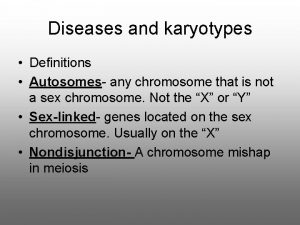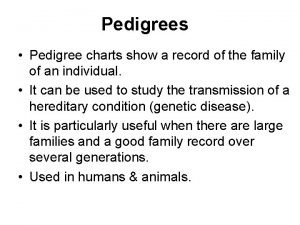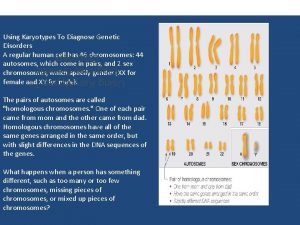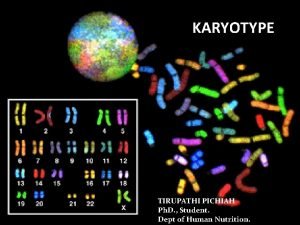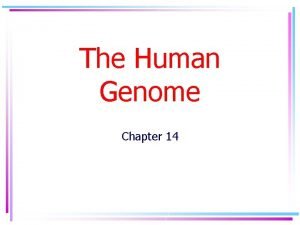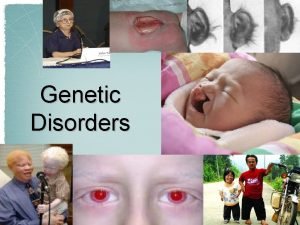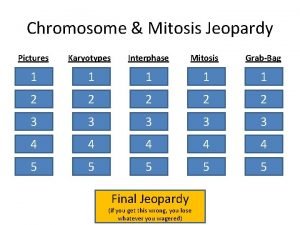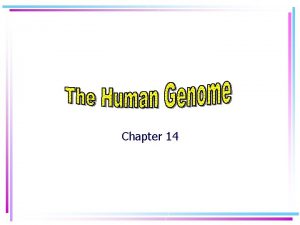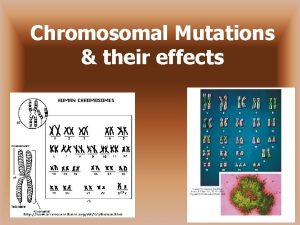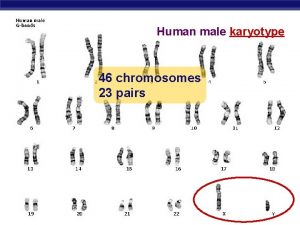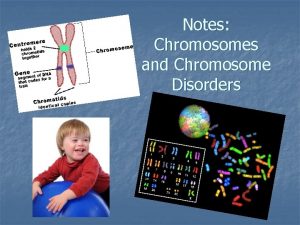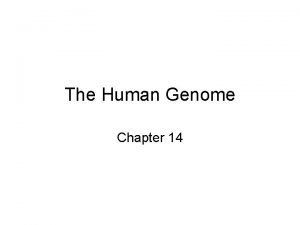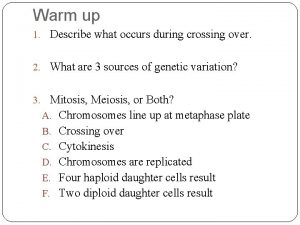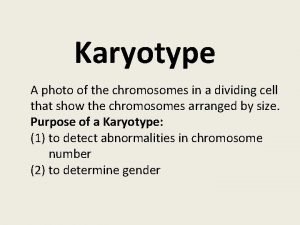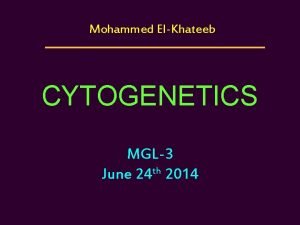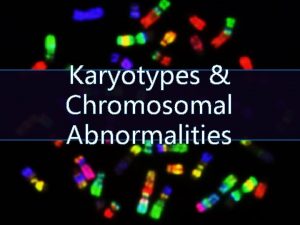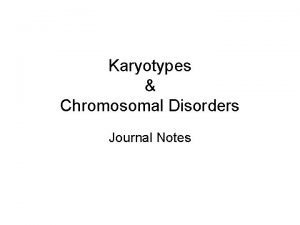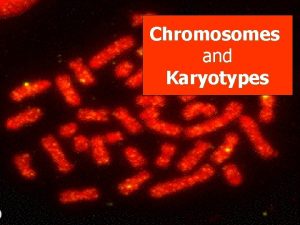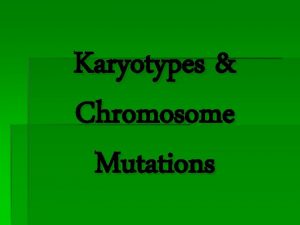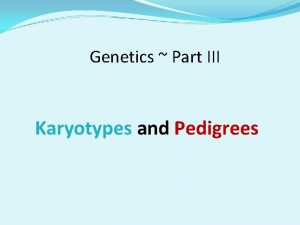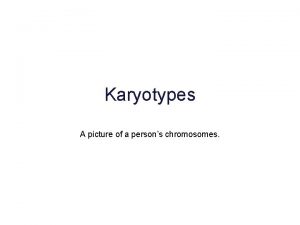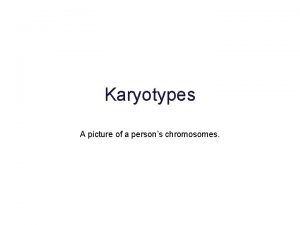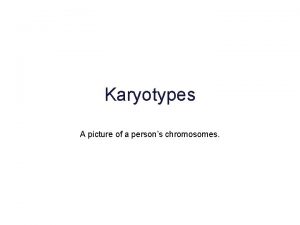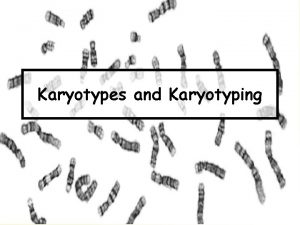Karyotypes 1 I What is a Karyotype Karyotype























- Slides: 23

Karyotypes 1

I. What is a Karyotype? • Karyotype = a test to identify and evaluate the size, shape, and number of chromosomes in a sample of body cells. • Extra, missing, or abnormal positions of chromosome pieces can cause problem’s with a person’s growth, development, and body functions. 2

Examples: Normal Female Normal male 3

II. Why Is It Done? 1. Determine whether the chromosomes of an adult have an abnormality that can be passed on to a child. 2. Determine whether a chromosomes defect is preventing a woman from becoming pregnant or causing miscarriages. 3. Determine whether a chromosome defect is present in a fetus. 4

II. Why Is It Done? 4. Determine the cause of a baby’s birth defects or disability. 5. Identify the sex of a person by determining the presence of the Y chromosome. • May be done when a newborn’s sex is not clear. 5

III. How is A Karyotype Created? 1. Human karyotypes are usually prepared from photographs of chromosomes that have been spread, fixed, and stained to highlight banding patterns. 2. The chromosomes on the photograph are cut apart and then arranged in homologous pairs just as you will be doing in an upcoming activity. 6

III. How is A Karyotype Created? 3. Chromosomes are obtained through various test: blood, bone marrow, amniotic fluid, or tissue from the placenta (the organ that develops during pregnancy to feed a growing baby). • White blood cells are used most frequently because they are easily induced to divide and grow in culture. 7

• To test amniotic fluid, an amniocentesis is done. A long needle will withdrawal fluid surrounding the fetus. It will contain cells shed by the fetus. • A bone marrow specimen requires a bone marrow biopsy. 8

III. How Is A Karyotype Created? 4. The sample is placed into a special dish and allowed to grow in the laboratory. 5. Various chemicals are added to stop the cell’s growth during prophase and metaphase. 6. The cells are placed on a microscope slide and treated so they swell and their chromosomes spread apart. 9

III. How Is A Karyotype Created? 7. Then various stains are used to highlight banding patterns. 8. Experienced geneticists observe the karyotype for chromosomal abnormalities • Missing pieces of chromosomes • Missing chromosomes • Extra chromosomes • The sex of the person 10

11

III. How Is A Karyotype Created? 9. The treated chromosomes can then be photographed, enlarged, if desired, and cut out to do the karyotype. 12

IV. What are Genetists Looking For? 1. Differences in sizes of chromosomes 2. Differences in the position of the centromeres • This is brought about by translocations. 3. Differences in basic number of chromosomes = (aneuploidy) 13

n o s e m i t m i l o a C m. r V no b A 14

Down Syndrome (Trisomy 21) • Cause = nondisjunction of the 21 st pair of chromosomes 15

Down Syndrome • Characteristics • Happens equally in males and females since it does not involve the sex chromosomes • Individuals have mental disabilities but the severity varies with the individual. • The probability of giving birth to a child with Down syndrome increases with the age of the mother, increasing significantly after age 35. 16

Turner’s Syndrome (monosomy) • Cause = nondisjunction of the sex chromosomes during meiosis so individuals are missing one copy of the X chromosome. • They have 22 pairs of autosomal chromosomes and only one X chromosomes. 17

Turner Syndrome • Characteristics • Affects only females • Women are usually short, sexually underdeveloped, and sterile. • Women with this function well within society and are not diagnosed until they are assessed for infertility as adults. 18

Klinefelter's Syndrome (trisomy) • Cause = nondisjunction of the sex chromosomes during meiosis so individuals have an extra X chromosome. • The person has 22 pairs of autosomal chromosomes and 3 sex chromosomes (XXY) 19

Klinefelter's syndrome • Characteristics • Affects only males • Males are often tall, sexually underdeveloped and may have slight intellectual impairment. • Recognition of this syndrome before puberty does not occur. • Many males with this function well within society and are not diagnosed until they are assessed for infertility as adults. 20

Jacob’s Syndrome (XYY) (trisomy) • Cause – occurs when a male inherits two Y chromosomes from his father instead of one. The exact cause of why this occurs is unknown. • He is an XYY male. 21

Jacob’s Syndrome (XYY) • Characteristics • Affects only males • The most common symptoms are learning problems at school and delayed emotional maturity. • Males are tall, thin, have acne, speech problems, and reading problems. 22

• Treacher Collins Syndrome video • Another video 23
 Pedigrees and karyotypes
Pedigrees and karyotypes Disorder
Disorder Why are karyotypes useful diagrams
Why are karyotypes useful diagrams Reading karyotypes
Reading karyotypes Using karyotypes to diagnose genetic disorders
Using karyotypes to diagnose genetic disorders The karyotypel has a turner syndrome
The karyotypel has a turner syndrome Tirupathi pichiah
Tirupathi pichiah Sickle cell karyotype
Sickle cell karyotype Pedigrees and karyotypes
Pedigrees and karyotypes Karyotype of klinefelter syndrome
Karyotype of klinefelter syndrome What are some uses of analyzing karyotypes?
What are some uses of analyzing karyotypes? Xxy syndrome
Xxy syndrome Name of cell
Name of cell Hemophilia karyotype picture
Hemophilia karyotype picture Karyotype mutations
Karyotype mutations Karyotype of a male
Karyotype of a male 46 chromosomes
46 chromosomes Hemophilia karyotype picture
Hemophilia karyotype picture Chromosome makeup
Chromosome makeup Whats a nondisjunction
Whats a nondisjunction Karyotype
Karyotype Whats a karyotype
Whats a karyotype How to read chromosome
How to read chromosome Karyotyping
Karyotyping

